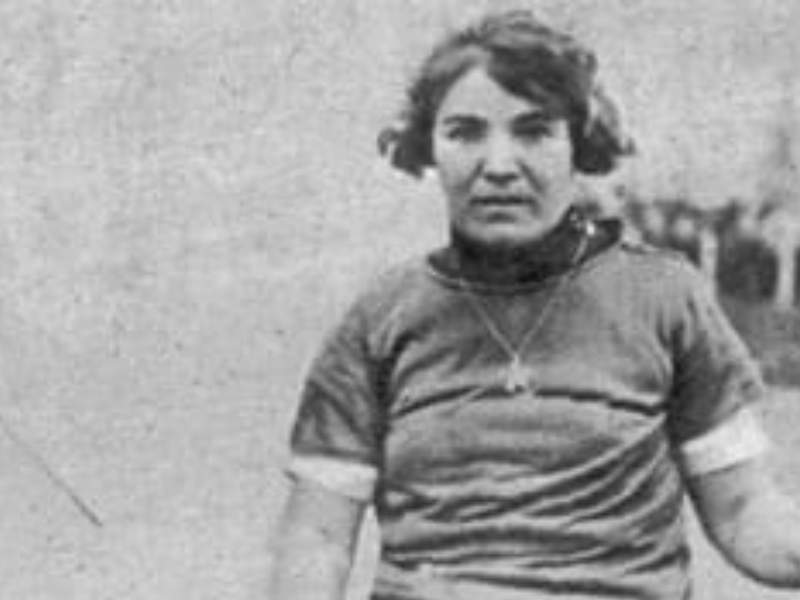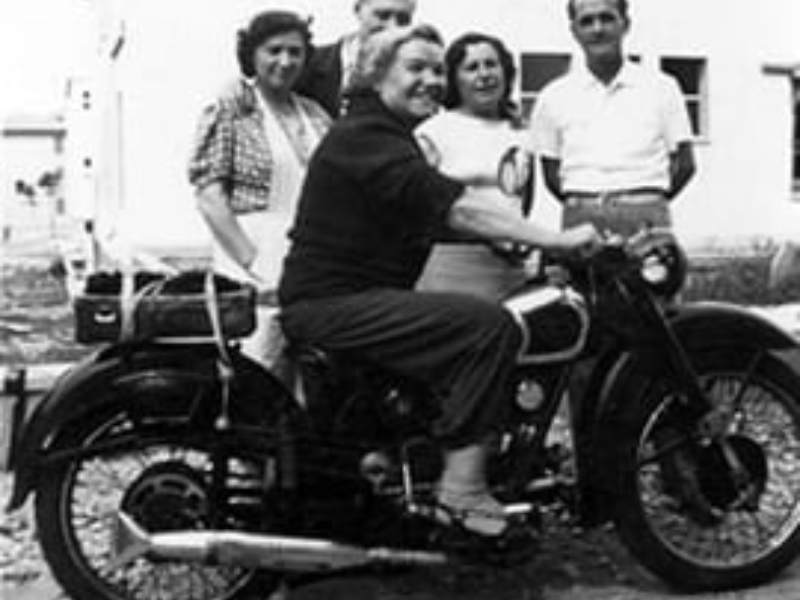Last Updated on 23 May 2024 by Cycloscope

In 1924, Alfonsina entered the Giro d’Italia, disguising herself as a man, she was the only woman to have competed in the most prestigious men’s cycling races.
In Italy in the early 1900 bicycle use was hampered by many. According to anthropologist Cesare Lombroso in his essay “Cycling in the Crime”, the bike would have favored delinquency, the Curia forbids priests to ride, and in Rome and Milan was forbidden to ride a bicycle after sunset. With a woman riding a bicycle scandal was guaranteed.
Alfonsina Morini was born in 1891 in Castelfranco Emilia, a rural village in Bologna Province. Italy has been united for thirty years. Second of nine children. Illiterate parents. After a few years, the family moved to Fossamarcia, near Castenaso. In 1901 her father Carlo gets an old bicycle donated by the country’s doctor. In those days only a few could have a bicycle. For Alfonsina cycling was the only entertainment.
Italy wasn’t like France, where the bicycle had become a symbol of women’s emancipation. In 1896 in Ostend, Belgium, the first women’s cycling world championship took place (won by Belgian Hélène Dutrieux). In Italy, instead, a woman on a bicycle was seen literally as a manifestation of the devil by the Church.
Despite this cultural environment, in Bologna, there were 7,000 bicycles of the 100,000 in the nation. On Sundays, Alfonsina was telling her parents she was going to church, participating in the bicycle races in neighboring villages instead, often winning against males. Once she won a pig, which given the financial constraints of the family, was not too bad. But despite this, the family was called “crazy” by the villagers. That was a shame to have a daughter like that.
She began to train regularly and, in 1907, she went to Turin, where the “Unione Velocipedistica Italiana” had just been born. The club included several women, arousing less scandal than in the villages of the countryside. Here Alfonsina rides on both road and track.
Despite those early openings, public opinion, fueled by the press, kept a bad opinion that fully reflected the chauvinist mentality of the time. In 1910 “La Stampa Sportiva” wrote, “We don’t have any sympathy for the virago, the woman who makes 200 km cycling, who rows as a professional. This exercise is not suitable for the potential and health of women. They are feminine acrobatics stuff that we have to hit severely. “
Meanwhile, in 1911, Alfonsina set the women’s world Hour Record, with 37.192 kilometers per hour, 300 meters more than French Louise Roger eight years before. In 1915, she legalized her marriage with Luigi Strada, thus changing the name to Alfonsina Strada.
In 1917, a few days after the defeat of Caporetto, due to the lack of participants, Alfonsina’s application to Giro di Lombardia was accepted, she then could ride with champions like Girardengo and Pellissier, Thys, and Belloni.
But the chance of a lifetime comes in 1924, a special year for the Giro d’Italia, born in 1909. For economic issues the most prestigious houses decided to boycott the race, not registering the subscription of the most famous champions of the time like Girardengo and Brunero.
La Gazzetta dello Sport, the race’s organizer, was forced to include amateurs, together with professionals. Courgnet and Colombo, leaders of the pink newspaper, cling to each grip to compensate for the setback. In this perspective should be considered Alfonsina’s participation. It was just a publicity stunt.
Many went to see the Giro passing just to see this strange woman who rides a bicycle. She could wash only after all the male cyclists. She starts from Milan between the criticisms. The “Guerin Sportivo” dedicated a song, The Girina:
Alfonsina don’t despair,
if you get a flat we are a thousand,
ready to fill your hole

After the first stages, Alfonsina surprised even herself, she isn’t the last (54 of 57), 32 men already have retired.
Moreover, the Giro is hell, 3618 km of hell. The roads in many parts of the country are little more than strips of mud. If you fall, you have a puncture (or many), you will lose hours. The 304 km between Foggia and L’Aquila, the Giro reaches the sharp peaks of the Abruzzi, with the dreadful Macerone.
After a disastrous fall, Alfonsina replaced her broken handlebar with a broomstick borrowed from a housewife along the road. Towards Perugia, the surprising flood. She arrives out of regular time. But the jury allows her to continue the race. She is now an attraction.
In Rijeka, at the end of the longest stage of the Giro, 415 km from Bologna to Istria, Alfonsina declares to the press, that finally stops defining her as a frivolous “devil in a skirt”, appreciating the courage of the woman: “But what could I do? The whore? I have a husband to the asylum that I have to help, I have a child in school that costs me 10 Lire per day. I have good legs, and the fans in Italy (especially women and mothers) treat me with enthusiasm. I’ve had some disappointments, some mocked me, but I’m satisfied and I know I did well.”
The tour ends with the victory of Giuseppe Enrici after the duel with Federico Gay. Only 30 of the original 90 riders arrived in Milan. Alfonsina is among them.
In the following years, the opportunity to enroll in the Giro was denied to Alfonsina. But she participates anyway for long stretches, as she had done in her debut period, winning the friendship, esteem, and admiration of many journalists, riders, and cycling enthusiasts who continue to follow her exploits with curiosity.
Left widow by Luigi Strada, Alfonsina remarried in Milan, on December 9, 1950, with an ex-cyclist, Carlo Messori, with the help of whom she continues her sports activity until she decides to quit competitions. But her passion for cycling is not blown over. She opens, in fact, in Milan, in Via Varesina, a bicycle shop with a small workshop for repairs. Widow again in 1957, she keeps running the store by herself.
She rides her last race in 1956, sixty-five years old, a veteran, who won. She died in 1957, left alone with her cats, falling on the ground while trying to start her Guzzi 500 motorcycle. The women’s Giro d’Italia was born in 1988. Today, the highest peak of the Giro d’Italia Women is the Cima Alfonsina Strada. In France the first female edition of the Tour de France was in 2022.
For more complete documentation about Alfonsina check out the book “Het roerige leven van Alfonsina Strada: de enige vrouw die ooit de Giro reed” by Paolo Facchinetti. This book is only available in Italian and Dutch.


